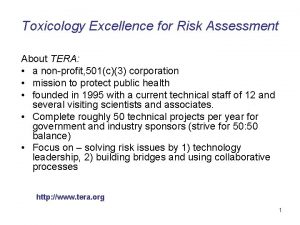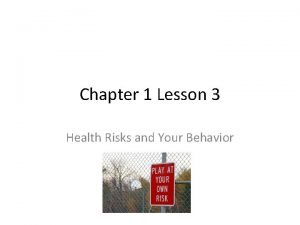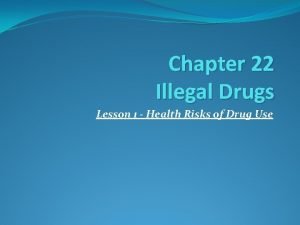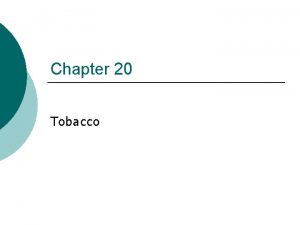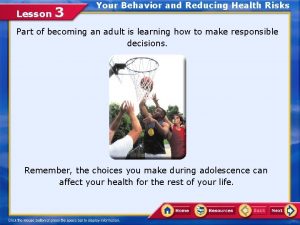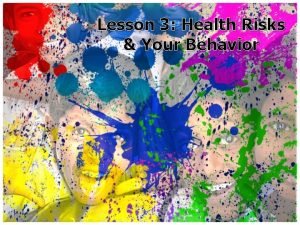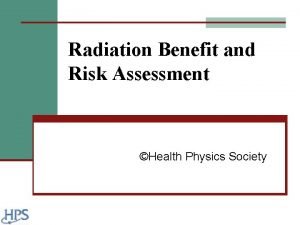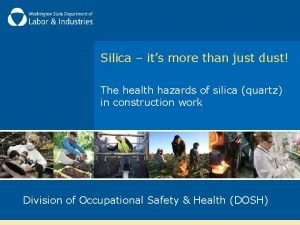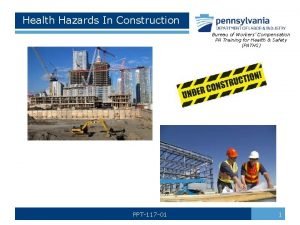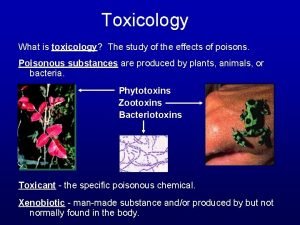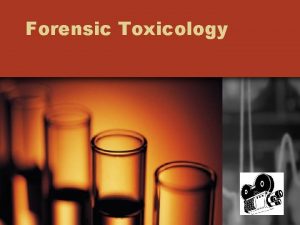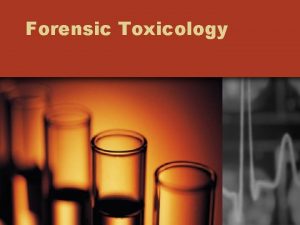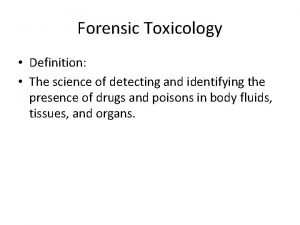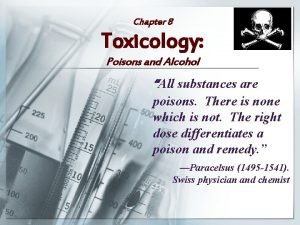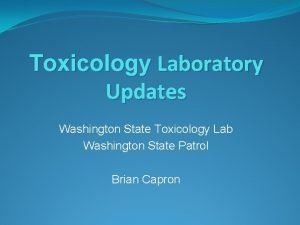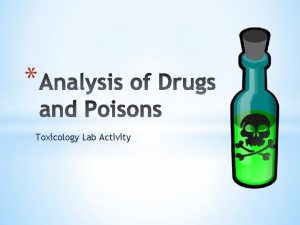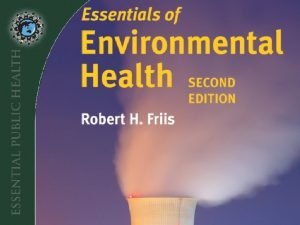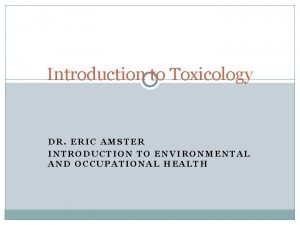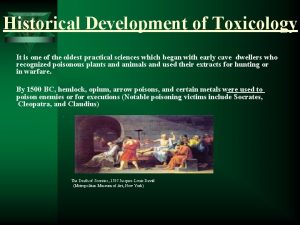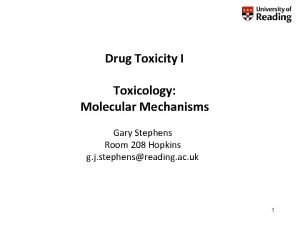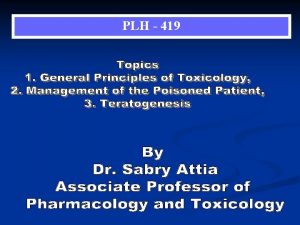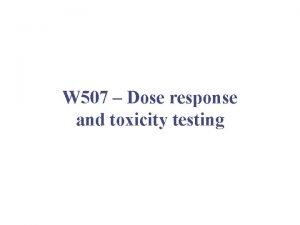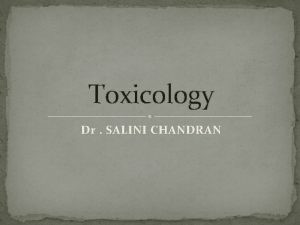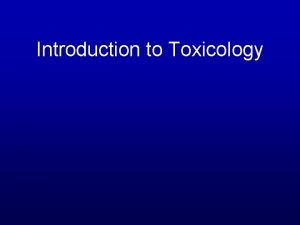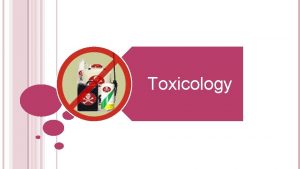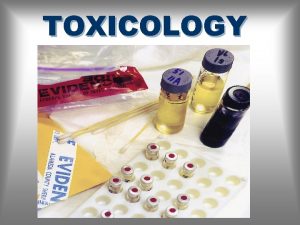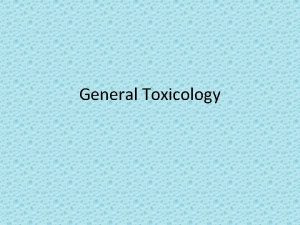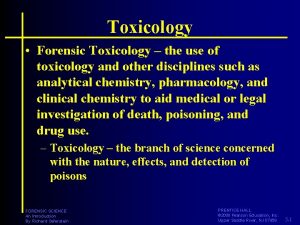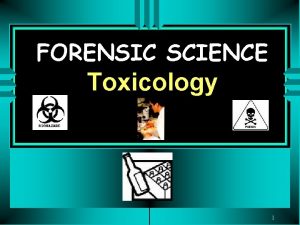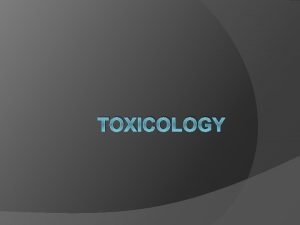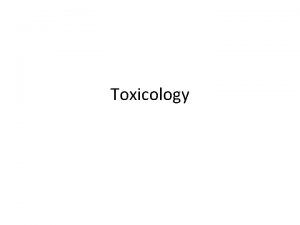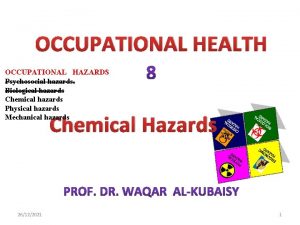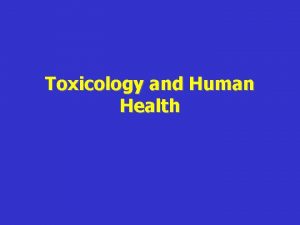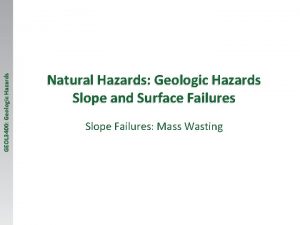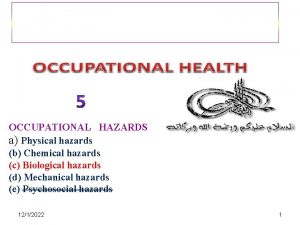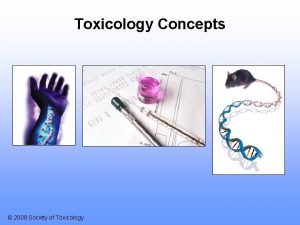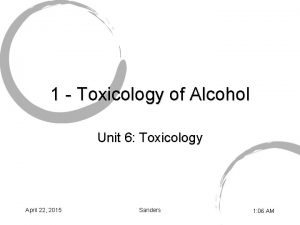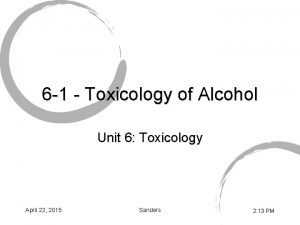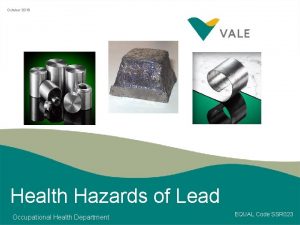Unit 6 Health Risk Toxicology Risks Hazards Risk





































- Slides: 37

Unit 6 –Health, Risk, Toxicology Risks & Hazards ØRisk is a measure of the likelihood that you will suffer harm from a hazard. ØWe can suffer from: Biological hazards: from more than 1, 400 pathogens. Chemical hazards: in air, water, soil, and food. Physical hazards: fire, earthquake, volcanic eruption… Cultural hazards: smoking, poor diet, unsafe sex, drugs, unsafe working conditions, and poverty. Ch. 15 7 deadliest infections kill 13. 6 million people worldwide every year Malaria Animation

Unit 6 –Health, Risk, Toxicology Point Source Chemical Hazards & Pollutants Non-Point Source (Area Source) Mobile Source Ch. 15

Unit 6 –Health, Risk, Toxicology Toxic Heavy Metals: • Mercury • Lead • Cadmium • Nickel • Gold • Platinum • Silver • Bismuth • Arsenic • Selenium* • Vanadium • Chromium • Thallium Each are: • Found in nature • Used in industry • By-products mining for other elements Ch. 15 *Not classified as a metal Metals tend to be stored in fatty tissue (sometimes permanently) creating a body burden (content of heavy metals in our bodies) Arsenic in Drinking Water Animation We all live with metals stored in our tissues Interactive Periodic Table

Unit 6 –Health, Risk, Toxicology Toxic Pathway & Biomagnification Ch. 15

Unit 6 –Health, Risk, Toxicology Ch. 15 Organic Compounds: Carbon compounds Synthetic Organic Compounds: 100, 00 chemicals have been commercially available. Wide range of adverse environmental effects Persistent Organic Pollutants (POP): Often contains volatile chlorine Resistant to environmental degradation Can be transported long distances by wind, water and sediments Many POPs are currently or were in the past used as pesticides. Others are used in industrial processes and in the production of a range of goods such as solvents, polyvinyl chloride, and pharmaceuticals. Dioxin Animation

Unit 6 –Health, Risk, Toxicology Hormonally Active Agent (HAA) A type of POP that effects the endocrine system Ch. 15

Unit 6 –Health, Risk, Toxicology Radiation Thermal Pollution Major cause of thermal pollution: Industrial process cooling Other causes: Soil Erosion Sedimentation -leads to shallower pools in waterways Deforestation -leads to more sunlight penetration on waterways Runoff from hot pavement Ch. 15

Unit 6 –Health, Risk, Toxicology Thermal Pollution Ch. 15 Directions Examine the data in the table below. It shows the concentration of dissolved oxygen available in water at different temperatures. The oxygen available to fish is in units marked ppm or "parts per million. " 1. Construct a line graph of the data on the left. Water Concentration Temperature of Dissolved 2. A certain species of fish normally live in a pond (Degrees Oxygen that never exceeds the temperature of 10 Celsius) (ppm) degrees Celsius. this species of fish requires a dissolved oxygen level 9. 5 ppm. Industrial development has the potential of increasing the 20 9. 0 pond's temperature by releasing hot water 10 10. 5 produced during necessary process. Answer the questions below based on your knowledge of 0 14. 1 biology and using your graph. (a) According to your graph, at what temperature would the dissolved oxygen level in the pond drop below the required level? (b) What impact would the change in temperature have on the fish. Explain your reasoning in complete sentences. 30 7. 8 3. Using complete sentences, suggest two (2) ways of preventing thermal pollution and still have the industrial development occur. What environmental impacts would these preventions cause?

Unit 6 –Health, Risk, Toxicology Thermal Pollution Ch. 15 Directions Examine the data in the table below. It shows the concentration of dissolved oxygen available in water at different temperatures. The oxygen available to fish is in units marked ppm or "parts per million. " 1. Construct a line graph of the data on the left. Water Concentration Temperature of Dissolved 2. A certain species of fish normally live in a pond (Degrees Oxygen that never exceeds the temperature of 10 Celsius) (ppm) degrees Celsius. this species of fish requires a dissolved oxygen level 9. 5 ppm. Industrial development has the potential of increasing the 20 9. 0 pond's temperature by releasing hot water 10 10. 5 produced during necessary process. Answer the questions below based on your knowledge of 0 14. 1 biology and using your graph. (a) According to your graph, at what temperature would the dissolved oxygen level in the pond drop below the required level? (b) What impact would the change in temperature have on the fish. Explain your reasoning in complete sentences. 30 7. 8 3. Using complete sentences, suggest two (2) ways of preventing thermal pollution and still have the industrial development occur. What environmental impacts would these preventions cause?

Unit 6 –Health, Risk, Toxicology Thermal Pollution Ch. 15 1. Construct a line graph of the data on the left. 2. A certain species of fish normally live in a pond that never exceeds the temperature of 10 degrees Celsius. this species of fish requires a dissolved oxygen level 9. 5 ppm. Industrial development has the potential of increasing the pond's temperature by releasing hot water produced during necessary process. Answer the questions below based on your knowledge of biology and using your graph. (a) According to your graph, at what temperature would the dissolved oxygen level in the pond drop below the required level? (b) What impact would the change in temperature have on the fish. Explain your reasoning in complete sentences. 3. Using complete sentences, suggest two (2) ways of preventing thermal pollution and still have the industrial development occur. What environmental impacts would these preventions cause?

Unit 6 –Health, Risk, Toxicology Radiation Thermal Pollution Particulates Asbestos Electromagnetic Fields (EMF) Noise Pollution Cultural Ch. 15

Unit 6 –Health, Risk, Toxicology Ch. 15

Unit 6 –Health, Risk, Toxicology This is where knowing dose response curves of chemical exposure is useful Ch. 15

Unit 6 –Health, Risk, Toxicology Ch. 15 Dose response curve. Low concentrations may be harmful to life. As the concentration increases, it may be beneficial to life.

Ch. 15 Unit 6 –Health, Risk, Toxicology Dose response curves. ED-50: LD-50: TD-50: Effective Dose The dose that causes an effect in 50% of the test population Lethal Dose The dose at which 50% of the test population dies Toxic Dose The dose that is toxic (causes ill effects) to 50% of the test population

Unit 6 –Health, Risk, Toxicology Ch. 15

Unit 6 –Health, Risk, Toxicology Ch. 15

Ch. 16 Unit 6 –Health, Risk, Toxicology Natural Hazards: Potential for property damage & a threat to human well being Natural Disasters: Significant loss of life & property over a short time & in a specific location Catastrophe: Massive disaster requiring significant time and money for recovery Earthquake Vid Tsunami Vid Hurricane Vid Landslide Vid Floods Vid

Ch. 16 Unit 6 –Health, Risk, Toxicology Natural Hazards Fundamentals: Natural Hazards… …provide service functions … are predictable … can be linked to other hazards … severity is linked to the biological and physical environment … risk can be estimated … negative effects can be minimized … are creating more damage and loss of life than in the past

Ch. 16 Unit 6 –Health, Risk, Toxicology Natural Hazards Fundamentals: Natural Hazards… …provide service functions … are predictable … can be linked to other hazards … severity is linked to the biological and physical environment … risk can be estimated … negative effects can be minimized … are creating more damage and loss of life than in the past

Ch. 16 Unit 6 –Health, Risk, Toxicology … are predictable

Ch. 16 Unit 6 –Health, Risk, Toxicology … can be linked to other hazards … severity is linked to the biological and physical environment

Ch. 16 Unit 6 –Health, Risk, Toxicology … are creating more damage and loss of life than in the past Due to: Poor land-use planning & exponential human population growth

Unit 6 –Health, Risk, Toxicology Solid Waste Management: Ch. 30 EQ’s (ch. 30): 1. What are the advantages and disadvantages of: Recycling? Composting? Onsite disposal? Incineration? Open dumps? 2. How do the physical and hydrologic conditions at a site effect its suitability as a sanitary landfill? 3. What are the multiple barriers used in landfills and how are they monitored? 4. Why is the disposal of hazardous chemicals one of our most pressing environmental issues? 5. How are chemical wastes managed? 6. What problems are related to ocean dumping and why are they likely to persist for some time?

Ch. 30 Unit 6 –Health, Risk, Toxicology Integrated Waste Management: current dominant concept of waste management meant to manage municipal (MSW) and industrial solid wastes we produce and reduce or prevent their production. Can reduce solid waste making it to a landfill by 50% Reduce, Includes: R-R-R Reuse, R Composting ecycle Incineratio n Using organic w aste as fertilizer Burning com bustible wa ste at high tempe ratures fill d n a L Sanitry d n a , g n i at r t n e c n na i e Co t s a w d i l o s g coverin ined area conf

Ch. 30 Unit 6 –Health, Risk, Toxicology Composting Using organic waste as fertilizer

Unit 6 –Health, Risk, Toxicology Ch. 30 Incineration: “Waste to Energy” Releases: Dioxins (a POP) Heavy Metals Particulates Inorganic Acidic Gases (HCl, SOx, NOx) But… Vastly reduces waste volume (75%-95%) and creates energy Incineration Animation

Unit 6 –Health, Risk, Toxicology Landfills Open dumps: are fields or holes in the ground where garbage is deposited and sometimes covered with soil. Mostly used in developing countries. Ch. 30

Unit 6 –Health, Risk, Toxicology Landfills Ch. 30 Landfill Animation Sanitary landfills: solid wastes are spread out in thin layers, compacted and covered daily with a fresh layer of clay or plastic foam.

Unit 6 –Health, Risk, Toxicology Methane, ammonia, hydrogen sulfide and NOX Ch. 30 8 Ways pollutants from sanitary landfill may enter the environment Noxious liquid that percolates from the surface or through the waste via groundwater movement Heavy Metals

Noise and traffic Trade-Offs Dust Sanitary Landfills Advantages No open burning Little odor Low groundwater pollution if sited properly Can be built quickly Low operating costs Disadvantages Noise and traffic Dust Air pollution from toxic gases and volatile organic compounds Releases greenhouse gases (methane and CO 2) unless they are collected Groundwater contamination Can handle large amounts of waste Slow decomposition of wastes Filled land can be used for other purposes Discourages recycling, reuse, and waste reduction No shortage of landfill space in many areas Eventually leaks and can contaminate groundwater

Unit 6 –Health, Risk, Toxicology Ch. 30 Hazardous Materials: material that is toxic, ignitable, corrosive, or reactive enough to explode or release toxic fumes. • The two largest classes of hazardous wastes are organic compounds (e. g. pesticides, PCBs, dioxins) and toxic heavy metals (e. g. lead, mercury, arsenic).

Unit 6 –Health, Risk, Toxicology Ch. 30 Hazardous Waste Legislation: Two major federal laws regulate the management and disposal of hazardous waste in the U. S. : ØResource Conservation and Recovery Act (RCRA) • Cradle-to-the-grave system to keep track waste. ØComprehensive Environmental Response, Compensation, and Liability Act (CERCLA) • Commonly known as Superfund program. • The Superfund law was designed to have polluters pay for cleaning up abandoned hazardous waste sites. • Only 70% of the cleanup costs have come from the polluters, the rest comes from a trust fund financed until 2002 by taxes on chemical raw materials and oil. Love Canal Animation

Unit 6 –Health, Risk, Toxicology Hazardous Waste Storage: Deep-well disposal: liquid hazardous wastes are pumped into dry porous rock far beneath aquifers. Surface impoundments: ponds, pits, or lagoons into which liners are placed and liquid hazardous wastes are stored. Long-Term Retrievable Storage: Some highly toxic materials cannot be detoxified or destroyed. Metal drums are used to stored them in areas that can be inspected and retrieved. Secure Landfills: Sometimes hazardous waste are put into drums and buried in carefully designed and monitored sites. Ch. 30

Ch. 30 Unit 6 –Health, Risk, Toxicology Ocean Dumping: Marine debris on the coast of Hawaii TED - Oceans of Plastic

Unit 6 –Health, Risk, Toxicology External Costs of Production Pollution has a cost Supply Demand Model with the Typicaland Supply and Demand Model addition of external costs Ch. 30

Unit 6 –Health, Risk, Toxicology “There is no away” Ch. 30
 Physical hazards
Physical hazards Understanding hazards and risks
Understanding hazards and risks Toxicology excellence for risk assessment
Toxicology excellence for risk assessment The biggest risk is not taking any risk
The biggest risk is not taking any risk Chapter 1 lesson 3 health risks and your behavior
Chapter 1 lesson 3 health risks and your behavior Chapter 22 lesson 1 the health risks of drug use
Chapter 22 lesson 1 the health risks of drug use A thick, sticky, dark fluid produced when tobacco burns.
A thick, sticky, dark fluid produced when tobacco burns. Chapter 1 lesson 3 health risks and your behavior
Chapter 1 lesson 3 health risks and your behavior Chapter 1 lesson 3 health risks and your behavior
Chapter 1 lesson 3 health risks and your behavior Health risks
Health risks Lifewave antenna
Lifewave antenna Chapter 20 lesson 1 the health risks of tobacco use
Chapter 20 lesson 1 the health risks of tobacco use Ghs pictogram depicts which hazard
Ghs pictogram depicts which hazard Silica health hazards
Silica health hazards Health hazards in construction ppt
Health hazards in construction ppt Liquidity measures
Liquidity measures Toxicology is the study of
Toxicology is the study of Important people in forensics
Important people in forensics A breath test reflects the alcohol concentration in the:
A breath test reflects the alcohol concentration in the: Forensic toxicology definition
Forensic toxicology definition Forensics toxicology definition
Forensics toxicology definition Environmental toxicology definition
Environmental toxicology definition Chapter 8 toxicology poisons and alcohol
Chapter 8 toxicology poisons and alcohol Toxicology types
Toxicology types Toxicology management
Toxicology management Wsp toxicology lab
Wsp toxicology lab Forensic toxicology lab activity
Forensic toxicology lab activity Toxicology definition
Toxicology definition Toxicology and applied pharmacology
Toxicology and applied pharmacology Nc medical examiner and coroner guidelines
Nc medical examiner and coroner guidelines Toxicology
Toxicology Examples of toxicology
Examples of toxicology Therapeutic index
Therapeutic index Toxicology
Toxicology Toxicology defination
Toxicology defination Accipitridae
Accipitridae Annual review of pharmacology and toxicology
Annual review of pharmacology and toxicology Importance of toxicology
Importance of toxicology


